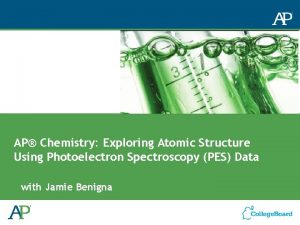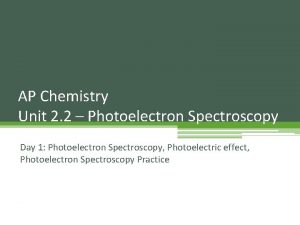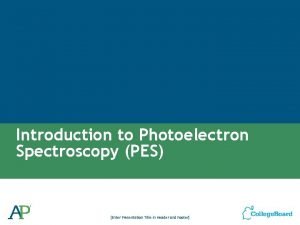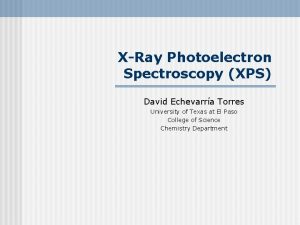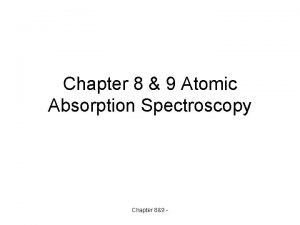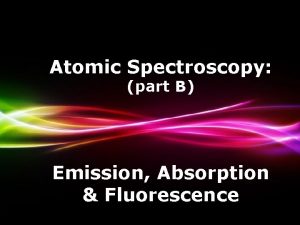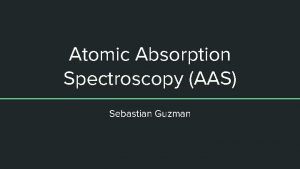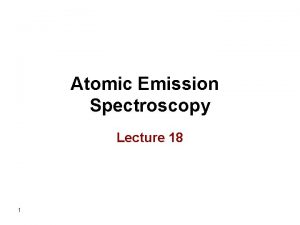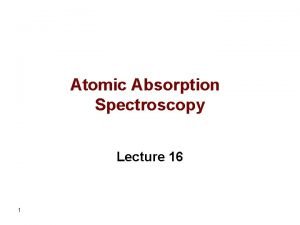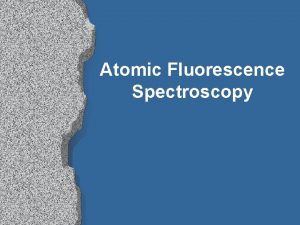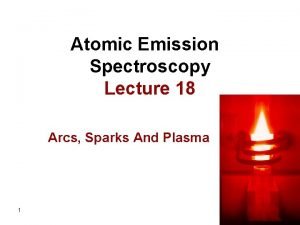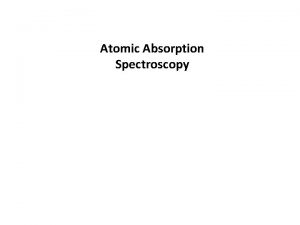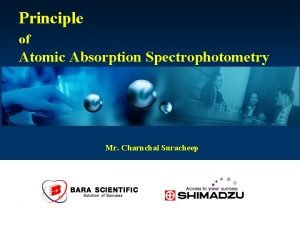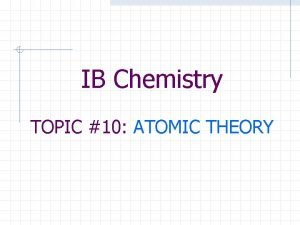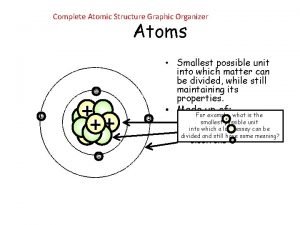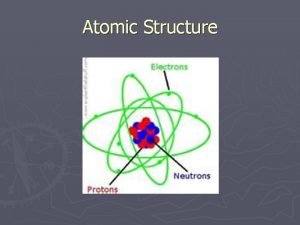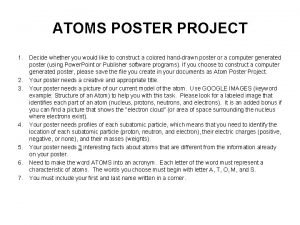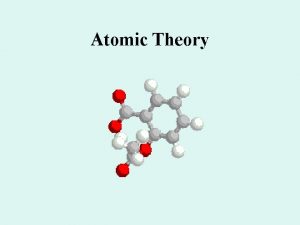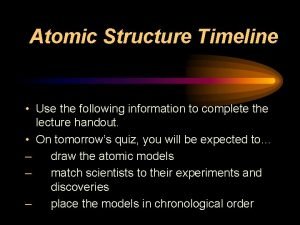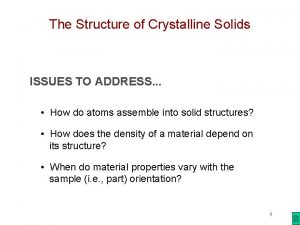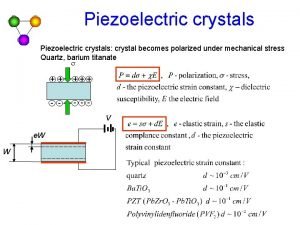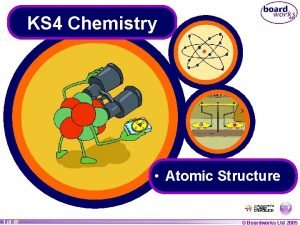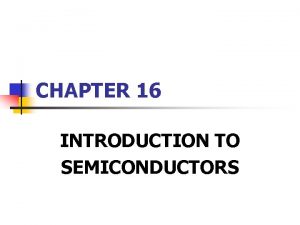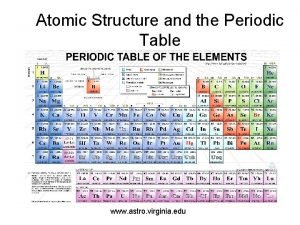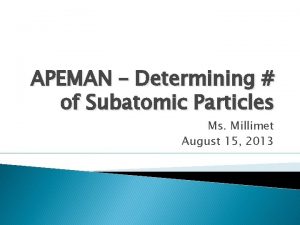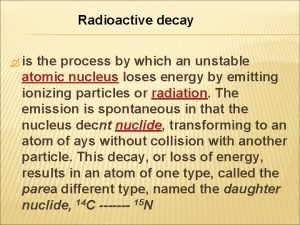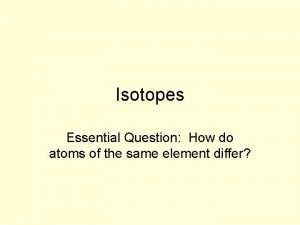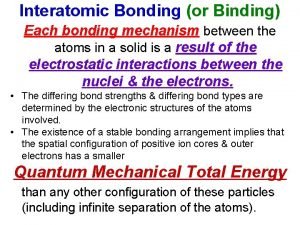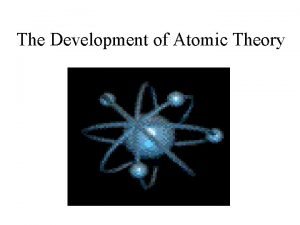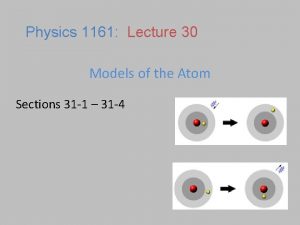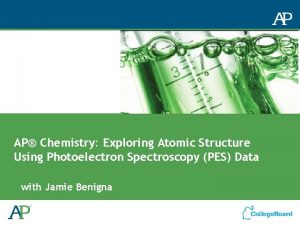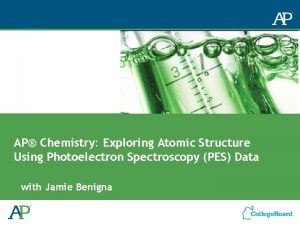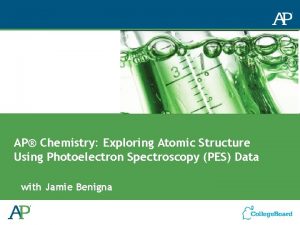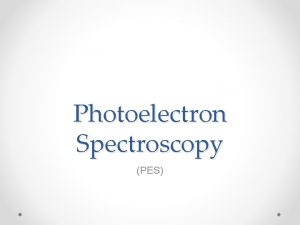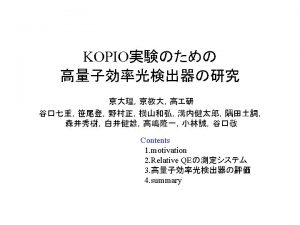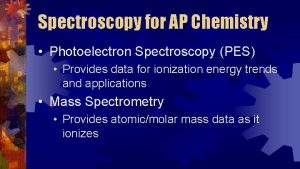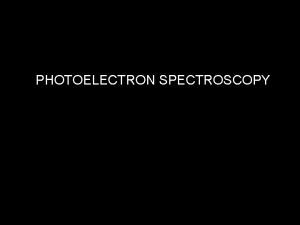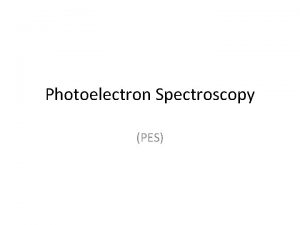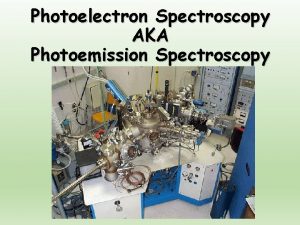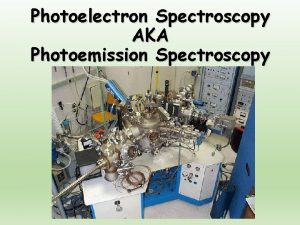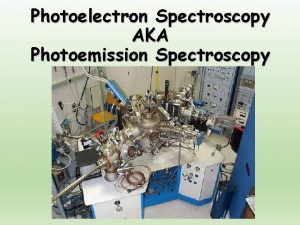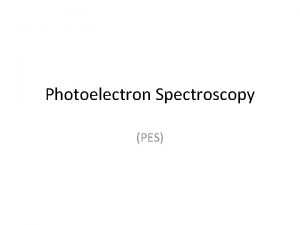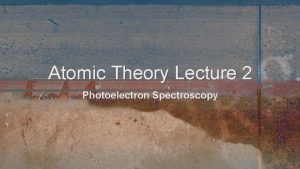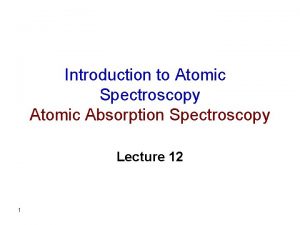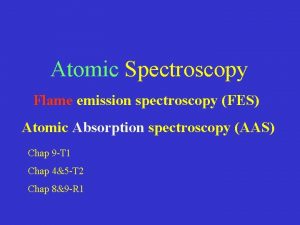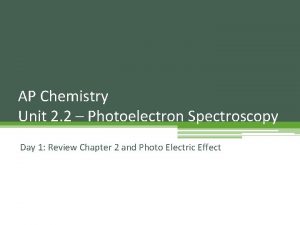AP Chemistry Exploring Atomic Structure Using Photoelectron Spectroscopy













![Introduction to Photoelectron Spectroscopy (PES) [Enter Presentation Title in Header and Footer] Introduction to Photoelectron Spectroscopy (PES) [Enter Presentation Title in Header and Footer]](https://slidetodoc.com/presentation_image/37bee463d85beb34634781107d572906/image-14.jpg)


![But not all elements ‘follow the rules’ 1 s [Ar]4 s 13 d 5 But not all elements ‘follow the rules’ 1 s [Ar]4 s 13 d 5](https://slidetodoc.com/presentation_image/37bee463d85beb34634781107d572906/image-17.jpg)











































- Slides: 60

AP® Chemistry: Exploring Atomic Structure Using Photoelectron Spectroscopy (PES) Data with Jamie Benigna

Before we begin, a few words about … Navigating the webcast College Board Equity and Access Policies

Navigating the Webcast Access document resources Access the audio transcript Navigate the course outline Set audio level Play, pause, next, previous A web browser w/ Flash plug-in enabled is required

Document Resources Instructor will reference student and teacher resources during the course Click on the Resources tab in the upper right hand corner of the player Find the file(s) in the popup and click to download Please download the resources now before continuing

Equity and Access Statement The College Board strongly encourages educators to make equitable access a guiding principle for their AP programs by giving all willing and academically prepared students the opportunity to participate in AP. We encourage the elimination of barriers that restrict access to AP for students from ethnic, racial and socioeconomic groups that have been traditionally underserved. Schools should make every effort to ensure their AP classes reflect the diversity of their student population. 4 The College Board also believes that all students should have access to academically challenging course work before they enroll in AP classes, which can prepare them for AP success. It is only through a commitment to equitable preparation and access that true equity and excellence can be achieved.

Equity and Access: Guiding Questions What does it mean to “provide all students with access to academically challenging course work before they enroll in AP classes? ” In what way has your math, science or STEM program already either addressed or been challenged by this goal? What opportunities must be provided in the curricula at all grades to ideally prepare students to compete and succeed in a global economy?

Time to begin … Warm welcome to our instructor – Jamie Benigna! Be sure to budget about 60 minutes to listen, read and complete the webcast and exercises

Hello from the Instructor Jamie Benigna • AP Chemistry Teacher, Department Coordinator The Roeper School, Birmingham, Michigan • AP Exam Reader • College Board Consultant • Development Committee Member • Food Stylist and Recipe Contributor to Viz. Chef cooking app

Why a webcast on PES? Chemists rely heavily on various methods of spectroscopy to understand the structure of atoms and molecules that are too small to see directly Photoelectron Spectroscopy (PES) is a powerful instrumental tool for probing the electronic structure of any of the naturally-occurring elements, as well as materials that contain mixtures of these elements This topic has been included in the redesigned AP® Chemistry course, and may not be well understood by students Image Source: SPECS Gmb. H

Course Overview In this webcast we will: Review the data that have led to various revisions of the atomic model Investigate the basic setup of PES instrumentation Explore the abilities and limitations of PES, and the analysis of the spectra produced by PES. Share many examples of: • Spectra • Student handouts appropriate for classroom use • Sample assessment items Reveal data sources and resources to learn more about PES

Learning Objectives By the end of this webcast, AP® Chemistry teachers will be prepared to teach: How PES can be used to probe the electronic structure of atoms, How the data from PES confirms the shell/subshell model of the atom, How PES data can be used alongside instruction on electron configurations, electron shielding, and the quantum mechanical model

Setting the Stage with a few foundational questions

![Introduction to Photoelectron Spectroscopy PES Enter Presentation Title in Header and Footer Introduction to Photoelectron Spectroscopy (PES) [Enter Presentation Title in Header and Footer]](https://slidetodoc.com/presentation_image/37bee463d85beb34634781107d572906/image-14.jpg)
Introduction to Photoelectron Spectroscopy (PES) [Enter Presentation Title in Header and Footer]

Various Models of the Atom + + - - + + -+ -+ + Dalton Thomson - - - ++ + ++++ - - + +++++++ Rutherford Bohr Image sources: http: //library. thinkquest. org/13394/angielsk/athompd. html http: //abyss. uoregon. edu/~js/21 st_century_science/lectures/lec 11. html http: //mail. colonial. net/~hkaiter/astronomyimages 1011/hydrogen_emis_spect. jpg http: //upload. wikimedia. org/wikipedia/commons/9/97/A_New_System_of_Chemical_Philosophy_fp. jpg

Further refinements to these models have occurred with new experimental results 5 f 7 s 6 p 6 s 5 p 5 d 4 d 5 s 4 p 4 s 3 p 3 s 2 p 2 s 1 s 3 d 4 f 1 s 2 s 3 s 4 s 5 s 6 s 7 s 8 s 2 p 3 p 4 p 5 p 6 p 7 p 3 d 4 d 4 f 5 d 5 f 6 d
![But not all elements follow the rules 1 s Ar4 s 13 d 5 But not all elements ‘follow the rules’ 1 s [Ar]4 s 13 d 5](https://slidetodoc.com/presentation_image/37bee463d85beb34634781107d572906/image-17.jpg)
But not all elements ‘follow the rules’ 1 s [Ar]4 s 13 d 5 1 s [Ar]4 s 13 d 10 2 s 2 p 3 s 3 p 4 s 3 d 4 p 5 s 4 d 5 p 6 s 5 d 6 p 7 s 6 d 7 p 4 f 5 f

How do we know? hν - hν - +

Ionization Energy Image source: http: //chemistry. beloit. edu/stars/images/IEexpand. gif Image source: Dayah, Michael. “Dynamic Periodic Table. ” Accessed Sept. 5, 2013. http: //ptable. com/#Property/Ionization

Ionization Energy Element IE 1 IE 2 IE 3 IE 4 IE 5 IE 6 IE 7 Na 495 4, 560 Mg 735 1, 445 7, 730 Al 580 1, 815 2, 740 11, 600 Si 780 1, 575 3, 220 4, 350 16, 100 P 1, 060 1, 890 2, 905 4, 950 6, 270 21, 200 S 1, 005 2, 260 3, 375 4, 565 6, 950 8, 490 27, 000 Cl 1, 255 2, 295 3, 850 5, 160 6, 560 9, 360 11, 000 Ar 1, 527 2, 665 3, 945 5, 770 7, 230 8, 780 12, 000 LO 1. 5 - The student is able to explain the distribution of electrons in an atom or ion based upon data. LO 1. 6 - The student is able to analyze data relating to electron energies for patterns or relationships.

How do we probe further into the atom? Radiation Type ν E Aspects Probed Microwaves 109 – 1011 Hz 10 -7 – 10 -4 MJ/mol Molecular rotations Infrared (IR) 1011 – 1014 Hz 10 -4 – 10 -1 MJ/mol Molecular vibrations Visible (ROYGBV) 4 x 1014 – 7. 5 x 1014 Hz 0. 2 - 0. 3 MJ/mol Ultraviolet (UV) 1014 – 1016 Hz X-ray 1016 – 1019 Hz hν - - - 11+ - 102 – 105 MJ/mol - - hν 0. 3 – 100 MJ/mol - Valence electron transitions in atoms and molecules Core electron transitions in atoms

Removing Core Electrons - - 11+ hν - - Radiation Type X-ray ν 1016 – 1019 Hz E 102 – 105 MJ/mol Aspects Probed Core electron transitions in atoms

Removing Core Electrons hν - - 11+ hν - - - - Any frequency of light that is sufficient to remove electrons from the 1 st shell can remove electrons from any of the other shells.

PES Instrument Image Source: SPECS Gmb. H, http: //www. specs. de/cms/front_content. php? idart=267

Kinetic Energy Analyzer Kinetic X-ray or UV Source 6. 26 0. 52 Binding Energy (MJ/mol) 3+ 3+ 3+ 3+ 3+

Kinetic Energy Analyzer Negative Voltage Hemisphere Slightly Less Negative Voltage Hemisphere

If Kinetic energy is too high… Negative Voltage Hemisphere Slightly Less Positive Negative Voltage Hemisphere

If voltage is too high… Negative Voltage Hemisphere Slightly Less Positive Negative Voltage Hemisphere

Kinetic Energy Analyzer Kinetic X-ray or UV Source Li 6. 26 Binding Energy (MJ/mol) Boron 1. 36 0. 80 19. 3 5+ 5+ 3+ 3+ 5+ 5+ 3+ 3+ 5+ Binding Energy (MJ/mol) 5+ 3+ 3+ 5+ 0. 52 5+ 3+ 3+ 5+ 5+ 3+

Analyzing Data from PES Experiments

Relative Number of Electrons Analyzing data from PES 2 p 2. 0 1 s 2 s 84. 0 4. 7 + 90 80 70 60 50 40 30 20 10 Binding Energy (MJ/mol) Which of the following elements might this spectrum represent? (A)He (B)N (C)Ne (D)Ar 0

Relative Number of Electrons Analyzing data from PES 2 p 6 7. 9 1 s 2 2 s 2 3 s 2 151 12. 1 1. 09 3 p 1 0. 58 100 10 1 Binding Energy (MJ/mol) Given the spectrum above, identify the element and its electron configuration: (A)B (B)Al (C)Si (D)Na

Real Spectrum

Auger Transitions 11+ hν - - -

Real Spectrum Intensity (x 105 counts/s) 4 3. 5 3 2. 5 2 1. 5 0

Intensity (x 103 counts/s) Copper vs. Chromium 6 5 4 3 2 1 0

Mixtures of Elements 4 Intensity (x 105 counts/s) 3. 5 3 2. 5 2 1. 5 1 0. 5 100 90 80 70 60 50 40 30 Binding Energy (MJ/mol) 20 10 0

PES Sample Questions

Sample Question #1 Relative Number of Electrons Which element could be represented by the complete PES spectrum below? 100 10 (A) Li 1 Binding Energy (MJ/mol) (B) B (C) N 0. 1 (D) Ne

Sample Question #2 Intensity Which of the following best explains the relative positioning and intensity of the 2 s peaks in the following spectra? Li 12 10 8 6 4 Binding Energy (MJ/mol) 2 0 Intensity 14 Be 14 (A) (B) (C) (D) 12 10 8 6 4 Binding Energy (MJ/mol) 2 0 Be has a greater nuclear charge than Li and more electrons in the 2 s orbital Be electrons experience greater electron-electron repulsions than Li electrons Li has a greater pull from the nucleus on the 2 s electrons, so they are harder to remove Li has greater electron shielding by the 1 s orbital, so the 2 s electrons are easier to remove

Sample Question #3 Given the photoelectron spectra above for phosphorus, P, and sulfur, S, which of the following best explains why the 2 p peak for S is further to the left than the 2 p peak for P, but the 3 p peak for S is further to the right than the 3 p peak for P? Binding Energy (A) S has a greater effective nuclear charge than P, and the 3 p sublevel in S has greater electron repulsions than in P. (B) S has a greater effective nuclear charge than P, and the 3 p sublevel is more heavily shielded in S than in P. (C) S has a greater number of electrons than P, so the third energy level is further from the nucleus in S than in P. (D) S has a greater number of electrons than P, so the Coulombic attraction between the electron cloud and the nucleus is greater in S than in P.

Sample Question #4 Intensity (c/s) Looking at the complete spectra for Na and K below, which of the following would best explain the relative positioning of the 3 s electrons? Na 105 90 75 60 45 Binding Energy (MJ/mol) 30 15 0 Intensity (c/s) 130 K 400 350 300 250 200 150 Binding Energy (MJ/mol) 100 50 0

Sample Question #4 a 4 (A) (B) (C) (D) 3. 5 3 Na-3 s K-3 s Intensity (c/s) Looking at the spectra for Na and K below, which of the following would best explain the difference in binding energy for the 3 s electrons? 2. 5 2 1. 5 Binding Energy (MJ/mol) 1 0. 5 K has a greater nuclear charge than Na K has more electron-electron repulsions than Na Na has one valence electron in the 3 s sublevel Na has less electron shielding than K 0

Sample Question #4 b 4 (A) (B) (C) (D) 3. 5 3 Na-3 s K-3 s Intensity (c/s) Looking at the spectra for Na and K below, which of the following would best explain the difference in signal intensity for the 3 s electrons? 2. 5 2 1. 5 Binding Energy (MJ/mol) 1 0. 5 K has a greater nuclear charge than Na K has more electron-electron repulsions than Na Na has one valence electron in the 3 s sublevel Na has less electron shielding than K 0

Sample Question #5 Intensity (counts/s) Given the photoelectron spectrum below, which of the following best explains the relative positioning of the peaks on the horizontal axis? Image source: http: //www. rsc. org/ej/JM/2010/b 925409 a-f 2. gif (A) O has more valence electrons than Ti or C, so more energy is required to remove them (B) O has more electron-electron repulsions in the 2 p sublevel than Ti and C (C) Ti atoms are present in a greater quantity than O can C in the mixture. (D) Ti has a greater nuclear charge, but the 2 p sublevel experiences greater shielding than the 1 s sublevel.

Sample Question #6 Intensity (c/s) Given the photoelectron spectrum of scandium below, which of the following best explains why Scandium commonly makes a 3+ ion as opposed to a 2+ ion? 0. 63 0. 77 500 400 300 50 40 30 10 9 8 7 6 5 4 3 2 1 0 Binding Energy (MJ/mol) (A) Removing 3 electrons releases more energy than removing 2 electrons. (B) Scandium is in Group 3, and atoms only lose the number of electrons that will result in a noble gas electron configuration (C) The amount of energy required to remove an electron from the 3 d sublevel is close to that for the 4 s sublevel, but significantly more energy is needed to remove electrons from the 3 p sublevel. (D) Removing 2 electrons alleviates the spin-pairing repulsions in the 4 s sublevel, so it is not as energetically favorable as emptying the 4 s sublevel completely.

Example Formative Assessment Intensity On the photoelectron spectrum of magnesium below, draw the spectrum for aluminum 100 10 Binding Energy (MJ/mol) 1 Hint: for additional formative assessments, use spectra from previous multiple choice questions

Intensity Quick Check – Can You Now Translate Between These Representations of Mg? 100 10 Binding Energy (MJ/mol) - 4 s 3 p 3 s 2 p 2 s 1 s 1 Mg - - - 12+ - - - 1 s 2 2 p 6 3 s 2

Using Data to Makes Conclusions About Atomic Structure + + -+ - + + Thomson image source: http: //ericsaltchemistry. blogspot. com/2010/10/jj-thomsons-experiments-with-cathode. html - - + +++++++ - +++ + +++ - Rutherford http: //84 d 1 f 3. medialib. glogster. com/media/f 9 a 5 f 2402 eb 205269 b 648 b 14072 d 9 fb 3 a 2 f 556367849 d 7 feb 5 cfa 4 a 8 e 2 b 3 fd 29/yooouu. gif Bohr

Relative Number of Electrons PES – Data that Shells are Divided into Subshells 2 p 6 7. 9 1 s 2 2 s 2 3 s 2 151 12. 1 1. 09 100 10 IE 4 0. 58 1 Binding Energy (MJ/mol) IE 3 3 p 1 Element IE 1 IE 2 IE 5 IE 6 IE 7 Na 495 4560 Mg 735 1445 7730 Al 580 1815 2740 11, 600 Si 780 1575 3220 4350 16, 100 P 1060 1890 2905 4950 6270 21, 200 S 1005 2260 3375 4565 6950 8490 27, 000 Cl 1255 2295 3850 5160 6560 9360 11, 000 Ar 1527 2665 3945 5770 7230 8780 12, 000

Applicable Science Practices From the AP Chemistry Curriculum Framework: SP 3. 2 • The student can refine scientific questions SP 3. 3 • The student can evaluate scientific questions SP 6. 3 • The student can articulate the reasons that scientific explanations are refined or replaced.

Wrap up and Take Aways

Applicable Learning Objectives From the AP Chemistry Curriculum Framework: 1. 5 – The student is able to explain the distribution of electrons in an atom or ion based upon data. 1. 6 – The student is able to analyze data relating to electron energies for patterns and relationships. 1. 7 – The student is able to describe the electronic structure of the atom, using PES data, ionization energy data, and/or Coulomb’s law to construct explanations of how the energies of electrons within shells in atoms vary. 1. 8 – The student is able to explain the distribution of electrons using Coulomb’s law to analyze measured energies. 1. 12 – The student is able to explain why a given set of data suggests, or does not suggest, the need to refine the atomic model from a classical shell model with the quantum mechanical model. 1. 13 – Given information about a particular model of the atom, the student is able to determine if the model is consistent with specified evidence. 1. 14 – The student can justify the selection of a particular type of spectroscopy to measure properties associated with vibrational or electronic motions of molecules.

Supporting Resources Download and use the webcast handouts Classroom activities • Shells Class Activity • From Shells to Subshells Class Activity Teacher resources • Spectrum generator spreadsheet • Peaks compiled (80 elements) • Frequently asked questions Testing items • Sample items referenced in this webcast (for classroom use, formative, or summative assessments)

Supporting Resources (cont. ) Arizona simulated photoelectron spectra http: //www. chem. arizona. edu/chemt/Flash/photoelectron. html Guided inquiry activities on PES • John Gelder (Oklahoma State University) • Moog and Farrell, Chemistry: A Guided Inquiry • POGIL Books on PES technical specs • Van der Heide, Paul. X-Ray Photoelectron Spectroscopy: An Introduction to Principles and Practices. New Jersey: John Wiley & Sons, Inc, 2012. • Ellis, Andrew M. , Miklos Feher, and Timothy Wright. Electronic and Photoelectron Spectroscopy: Fundamentals and Case Studies. New York: Cambridge University Press, 2005.

Supporting Resources (cont. ) AP Chemistry Teacher Community (resources section) https: //apcommunity. collegeboard. org/web/apchem Spectra search strings • • XPS X-ray photoelectron spectroscopy UVPS ESCA spectroscopy ESCA spectra Photoelectron spectrum Photoelectron spectroscopy

Supporting Resources (cont. ) Image Source: Shen Laboratory, Stanford University and SLAC National Accelerator Laboratory http: //arpes. stanford. edu/facilities_ssrl. html Image source: Inna M Vishik http: //www. stanford. edu/~ivishik/inna_vishik_fi les/Page 452. htm

Take Away You should now feel confident Explaining how data informs our understanding of the atom Using PES and experimental evidence to build mental models of atomic structure Explaining how a PES instrument collects data and how to analyze spectra

Contact Information Jamie Benigna AP Chemistry Development Committee Member jamie. benigna@roeper. org Serena Magrogan Director, Science Curriculum and Content Development (AP Chemistry) smagrogan@collegeboard. org

Thank you! Complete a survey on the course and receive Jamie’s summer reading list! Survey: https: //www. surveymonkey. com/s/3 FNCLPG
 Photoelectron spectroscopy ap chemistry
Photoelectron spectroscopy ap chemistry Pes2p
Pes2p Draw a photoelectron spectrum for aluminum
Draw a photoelectron spectrum for aluminum Xps instrument
Xps instrument Prinsip kerja aas
Prinsip kerja aas Theory of atomic absorption spectroscopy
Theory of atomic absorption spectroscopy Fluorescence spectroscopy ppt
Fluorescence spectroscopy ppt Principles of atomic emission spectroscopy
Principles of atomic emission spectroscopy Atomic absorption spectroscopy history
Atomic absorption spectroscopy history Difference between atomic and molecular spectroscopy
Difference between atomic and molecular spectroscopy Catalysis lecture notes
Catalysis lecture notes Flame photometry instrumentation
Flame photometry instrumentation Interference of atomic absorption spectroscopy
Interference of atomic absorption spectroscopy Atomic absorption spectroscopy
Atomic absorption spectroscopy Atomic fluorescence spectroscopy principle
Atomic fluorescence spectroscopy principle Atomic emission spectroscopy lecture notes
Atomic emission spectroscopy lecture notes Schematic diagram of atomic absorption spectroscopy
Schematic diagram of atomic absorption spectroscopy Atomic absorption spectrophotometry principle
Atomic absorption spectrophotometry principle Atomic structure and properties ap chemistry
Atomic structure and properties ap chemistry Ib chemistry atomic structure
Ib chemistry atomic structure Ap chemistry atomic structure and periodicity
Ap chemistry atomic structure and periodicity Oxygen periodic trends
Oxygen periodic trends Ib chemistry atomic structure
Ib chemistry atomic structure Relative atomic mass of beryllium
Relative atomic mass of beryllium Atomic size vs atomic radius
Atomic size vs atomic radius Atomic radius chart
Atomic radius chart How to calculate abundance of isotopes
How to calculate abundance of isotopes Differentiate between atomic number and mass number
Differentiate between atomic number and mass number Atomic number vs atomic radius
Atomic number vs atomic radius Forensics
Forensics Ib chemistry functional groups
Ib chemistry functional groups Organic vs inorganic chemistry
Organic vs inorganic chemistry Particles table
Particles table Democritus diagram
Democritus diagram Atomic structure of a conductor
Atomic structure of a conductor Atomic theory graphic organizer
Atomic theory graphic organizer Atomic model timeline project
Atomic model timeline project Z atomic symbol
Z atomic symbol Tungsten atomic structure
Tungsten atomic structure 460 democritus atom model
460 democritus atom model Atom poster project
Atom poster project Bohr model vs quantum model venn diagram
Bohr model vs quantum model venn diagram Atomic model schrodinger
Atomic model schrodinger Dalton atom modeli
Dalton atom modeli History of the atom webquest
History of the atom webquest Atomic packing factor of fcc structure is
Atomic packing factor of fcc structure is Piezoelectric crystal atomic structure
Piezoelectric crystal atomic structure Boardworks atomic structure
Boardworks atomic structure Atomic structure of semiconductor
Atomic structure of semiconductor Chapter 4 atomic structure vocabulary
Chapter 4 atomic structure vocabulary Chapter 4 atomic structure
Chapter 4 atomic structure Atomic structure and the periodic table
Atomic structure and the periodic table Atomic structure
Atomic structure Nitrogen apeman
Nitrogen apeman 4 forces of nature
4 forces of nature Tungsten atomic structure
Tungsten atomic structure What does the atomic number represent
What does the atomic number represent Atomic structure and interatomic bonding
Atomic structure and interatomic bonding Discovery of atomic structure
Discovery of atomic structure Robert millikan atomic model
Robert millikan atomic model Bohr radius of hydrogen atom
Bohr radius of hydrogen atom
